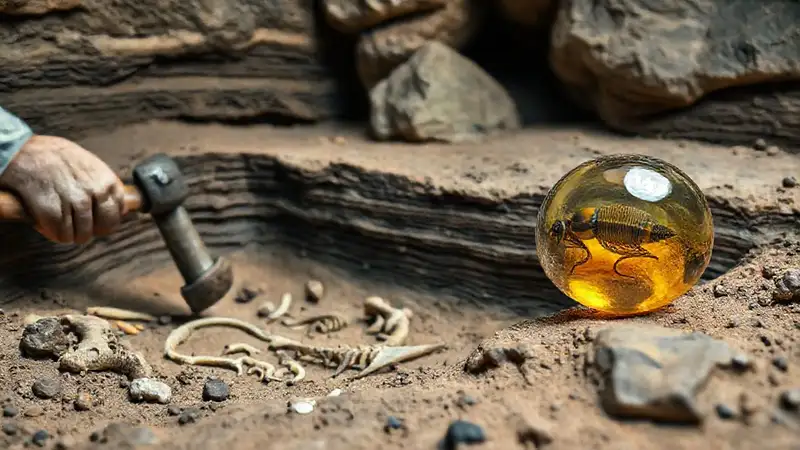Paleontology is a fascinating scientific discipline dedicated to understanding life from the distant past. It utilizes the study of fossils – preserved remains or traces of ancient organisms – to reconstruct ecosystems and unravel the evolutionary history of our planet. It's a multi-faceted field, drawing upon geology, biology, chemistry, and even computer science, allowing scientists to piece together incredible stories of extinct creatures and environments. The quest to understand these ancient beings is a continuous journey, constantly revealing new insights and challenging existing theories.
Fossils aren't just found in museums; they're scattered across the globe, embedded in rock formations that tell a story of geological time. The process of fossilization is incredibly rare, representing a specific set of conditions that must be met for organic material to be transformed into a durable record of life. Understanding how these transformations occur is central to paleontological research and allows us to accurately date and interpret the fossils we uncover.
The Initial Death and Decay
The initial stages of fossilization are often overlooked but are crucial to the entire process. When an organism dies, its body begins to decay. The speed of this decomposition depends greatly on the environment – a dry, arid climate will accelerate the process significantly more than a swampy, anaerobic one. Initially, scavengers and bacteria break down the soft tissues, stripping away muscle, skin, and organs. However, not everything is lost; bones, teeth, and shells often survive, as they are composed of denser, more resistant materials.
Furthermore, the surrounding sediment plays a vital role. The rate of decay is influenced by factors such as temperature, humidity, and the presence of oxygen. The more rapidly the remains decay, the less likely it is that a detailed fossil will be preserved. Therefore, a relatively rapid death, followed by a quick burial, increases the odds of successful fossilization. It's a delicate balance between destruction and preservation.
Finally, the type of organism also matters. Animals with heavy bones – like dinosaurs – have a higher chance of fossilization than those with lighter, more fragile skeletons. The density of the bone material contributes to its ability to withstand the forces of erosion and geological disturbance.
Burial and Sedimentation
Once the initial decomposition slows, the process of burial becomes the primary driver of fossilization. Rapid burial is absolutely essential. If an organism is exposed to the elements (sun, rain, wind) for a prolonged period, the soft tissues will be completely destroyed. Sediment, such as mud, sand, or silt, needs to cover the remains, shielding them from the destructive forces of nature.
As layers of sediment accumulate, the pressure from above compacts the lower layers, gradually turning them into sedimentary rock. This compaction also helps to prevent erosion and water infiltration, which would further damage the fossilized remains. The type of sediment is also important; fine-grained sediments, like clay, tend to preserve details better than coarser sediments, like gravel.
The geological context of the fossil – the type of rock it's found in and the surrounding layers – provides valuable information about the environment in which the organism lived and died. Paleontologists use this geological context to reconstruct the ancient landscape and understand the animal's habitat.
Mineralization and Replacement

Over millions of years, the organic material within the bone or shell gradually transforms into minerals. This process is known as mineralization. Water rich in dissolved minerals (like calcium carbonate or silica) seeps into the porous spaces within the bone or shell. These minerals then precipitate out of the water, replacing the original organic compounds with their mineral equivalents.
This replacement doesn’t necessarily destroy the original shape of the fossil. In fact, it often preserves the intricate details of the bone or shell with remarkable fidelity. A process called ‘permineralization’ is a specific type of mineralization where the empty spaces within the bone are filled with minerals. This strengthens the fossil and makes it much more durable.
The type of mineral that precipitates depends on the surrounding environment. In limestone environments, calcium carbonate is the dominant mineral, while in areas with volcanic activity, silica may be incorporated into the fossil. Analyzing the minerals present can reveal clues about the local conditions during fossilization.
Fossil Discovery and Research
Finding a fossil is only the beginning of the research process. Paleontologists employ a variety of techniques to excavate, clean, and analyze fossils. Excavation is a careful and methodical process, requiring specialized tools and a deep understanding of sedimentary geology. Careful documentation, including photographs and detailed notes, is crucial throughout the excavation.
Once recovered, fossils are painstakingly cleaned to remove any remaining sediment. This cleaning process can be incredibly delicate, as the fossil may be fragile and easily damaged. After cleaning, paleontologists use a variety of techniques to study the fossil, including microscopy, CT scanning, and chemical analysis. These methods allow them to analyze the fossil’s structure, composition, and age.
Ultimately, the goal is to reconstruct the anatomy and behavior of the ancient organism. This involves comparing the fossil to other fossils, studying the fossil’s geological context, and using biomechanical models to understand how the organism moved and interacted with its environment.
Conclusion
The study of paleontology continues to offer us incredible glimpses into the history of life on Earth. From the remarkable process of fossilization – a complex interplay of decay, burial, and mineralization – to the sophisticated techniques used to analyze fossils today, it's a field brimming with discovery. It is a testament to the persistence of scientific inquiry and the enduring fascination with the creatures that once roamed our planet.
As new fossils are unearthed and analytical methods become more refined, our understanding of dinosaurs and other extinct organisms will undoubtedly continue to evolve, revealing even more detailed and surprising stories about the past, constantly reshaping our perception of the evolutionary timeline.




Deja una respuesta